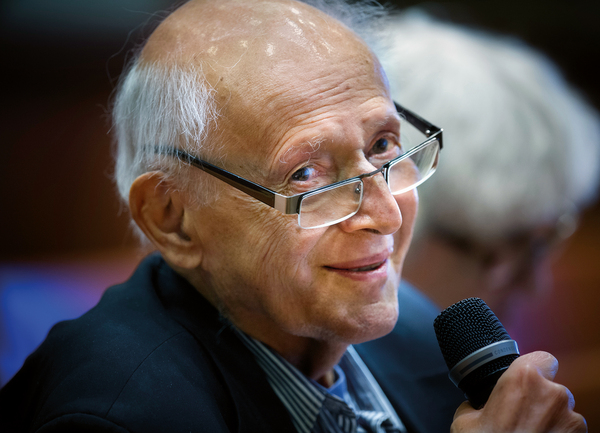George Klein, with his wife, Eva, discovered foundational phenomena in cancer research. He showed that normal cells carry genes, now known as tumour suppressors, that prevent cancer. He also worked out how the immune system comes to recognize and eliminate cancer cells.
Klein, who died on 10 December at the age of 91, had a youth filled with daring and peril. From a Hungarian–Jewish family, he escaped being sent to a Nazi labour camp and from Russian patrols during the Second World War. He began medical studies in Budapest at the end of the war. In 1947, against all odds, a well-connected colleague arranged for Klein and a few other students to visit universities in Sweden. He was offered a place in the laboratory of the renowned cell biologist Torbjörn Caspersson at the Karolinska Institute.
Klein risked a return to communist Hungary to marry Eva, a fellow medical student he had known for mere weeks, and brought her back with him. The necessary documents typically took months to assemble, but he and Eva acquired them over a single workday using persuasion, pluck and bribes. They completed their PhDs at the Karolinska and maintained research groups there until about a month before George’s death.
In 1957, a chair was created for him in tumour biology, a research field that he had helped to establish. The department of tumour biology that ensued was international and influential. Most of today’s leading cancer researchers who are over 50 have had some interaction with George and his department. Seven secretaries wrangled his large correspondence. He invented social media before the technology existed.
A seminal paper published in 1960 (G. Klein et al. Cancer Res. 20, 1561–1572; 1960) dissected the essential basis of modern tumour immunology. Before it, researchers thought that all cancers carried a common antigen that the immune system could recognize. The Kleins and their colleagues used a chemical carcinogen to induce tumours in mice, surgically removed these and immunized the animals with irradiated cells from their own tumours. Next, the group inoculated mice with viable cancer cells and demonstrated that the immune system would only reject cancerous cells if they came from the original tumour.
This clarified the field: the immune system could recognize and reject cancers, in a way that was specific to each individual. A year later, Klein’s team wrote a paper showing the other side of the coin (H. O. Sjögren et al. Cancer Res. 21, 329–337; 1961). Tumours caused by the mouse polyomavirus do indeed share a common antigen. This paved the way for the general observation that tumours caused by or carrying viruses share common antigens that the immune system can target.
The Kleins’ experimental success rested on two cornerstones. One was the establishment of a large colony of inbred mouse strains essential for tumour transplantation studies. After an early sabbatical at the Fox Chase Cancer Center in Philadelphia, George brought back 200 inbred mice on the return flight to found the colony.
The other was that the Kleins were among the first to apply concepts of population dynamics to cancer cells. This approach led to the demonstration of genes for tumour suppression (with their colleague at the Karolinska Francis Wiener and cell biologist Henry Harris) in the 1970s, at a time when it was not even clear that cancer had a genetic basis. This anticipated the modern view of cancer as resulting from the Darwinian evolution of cancer cells. Consecutive mutations in multiple genes increased the ability of wayward cells to survive, proliferate and evade checks against their growth.
Other seminal contributions included the prediction that translocations between chromosomes could activate oncogenes and the discovery of the Epstein-Barr virus nuclear proteins, which are crucial in the viral transformation of normal cells to a cancerous state. Their team (with Rolf Kiessling, then a graduate student at the Karolinska) also discovered, in 1975, natural killer cells, which can eliminate both cancerous and infected cells.
George showed an unusually high intellectual presence that mesmerized younger researchers. The tumour-biology department broke the boundaries of classic disciplines: it integrated genetics and mouse studies with cell biology, immunology and the study of infectious agents.
George also published books on the humanities, philosophy and popular science. Topics ranged from the Holocaust, atheism and religion to mysteries in cell biology and personal portraits of his heroes in science, music, poetry and literature. He was a leading public intellectual, often on Swedish television and in newspapers. His last book, Resistance (Albert Bonniers Förlag, 2015; published in Swedish), won the prestigious Gerard Bonnier prize for the best essay collection of that year. It deals with resistance to extremism and to cancer. Throughout his life, George was preoccupied with the thin borders between evil and good, and health and disease.
He was an admired lecturer for general and scientific audiences. His preferred format was conversation with an interesting opponent. There was a time when most major international cancer conferences concluded with his creative remarks. Many are those who can witness how much they were affected by bouncing ideas and results around with George.







